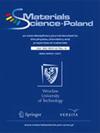添加MWCNT纳米添加剂后SS316L与纯铜旋转摩擦焊的力学和显微组织特性
IF 1.1
4区 材料科学
Q3 Engineering
引用次数: 0
摘要
本研究探索了旋转摩擦焊几何摩擦轮廓的新设计,以增强连接铜和316L不锈钢等异种合金的机械夹紧。摩擦型材的夹紧行为可以将焊缝的屈服保持在最大水平。通过定义摩擦轮廓,可以实现焊件区域有效混合的创新方法。不同金属相的有效分散可以由实现金属间SS-Cu相的几何轮廓来控制。通过改变焊接参数,如工具转速、镦粗压力、镦粗时间、摩擦压力和摩擦时间,为四种不同的摩擦轮廓(即螺旋形、正形、圆柱形和平面)找到合适的工艺,以减少具有强焊核的微观和宏观结构缺陷。结果表明,螺旋锚爪摩擦剖面具有明确的值,如焊缝熔核处的极限抗拉强度为217MPa(镦粗压力)、伸长率为9.8%(镦粗压)和平均硬度为125HV(摩擦压力)。显微组织特征证明,通过渗碳体等晶粒尺寸减小形成IMCs,提高了焊件的维氏硬度。本文章由计算机程序翻译,如有差异,请以英文原文为准。
Mechanical and Microstructural Characteristics of Rotary Friction Welded SS316L and Pure Copper with Added MWCNT Nano Additives
This study explores the novel design of geometric rubbing profiles on rotary friction welding for enhanced mechanical clamping in joining dissimilar alloys such as copper and stainless steel 316L. The clamping behavior of rubbing profiles could hold the yielding of the weld joint to a maximum level. An innovative approach to effective mixing of the weldment zone could be achieved through the definition of rubbing profiles. The effective dispersion of dissimilar metallic phases could be governed by the geometrical profile in achieving the intermetallic SS-Cu phase. Variations were made in welding parameters like tool rotational speed, upset pressure, upset time, friction pressure, and friction time to find the appropriate process for the four different rubbing profiles, namely helical fluke, plus, cylindrical, and flat to achieve a reduction in micro and macro-structural defects with strong weld nugget. Results show that helical fluke rubbing profiles were seen to have explicit values like ultimate tensile strength of 217 MPa (upset pressure), elongation of 9.8 % (upset pressure), and average hardness of 125 HV (friction pressure) at the weld nugget. Microstructural characteristics prove that the formation of IMCs through grain size reduction such as cementite increases the Vickers hardness of the weldment.
求助全文
通过发布文献求助,成功后即可免费获取论文全文。
去求助
来源期刊

Materials Science-Poland
工程技术-材料科学:综合
CiteScore
1.70
自引率
18.20%
发文量
0
审稿时长
6.2 months
期刊介绍:
Material Sciences-Poland is an interdisciplinary journal devoted to experimental research into results on the relationships between structure, processing, properties, technology, and uses of materials. Original research articles and review can be only submitted.
 求助内容:
求助内容: 应助结果提醒方式:
应助结果提醒方式:


